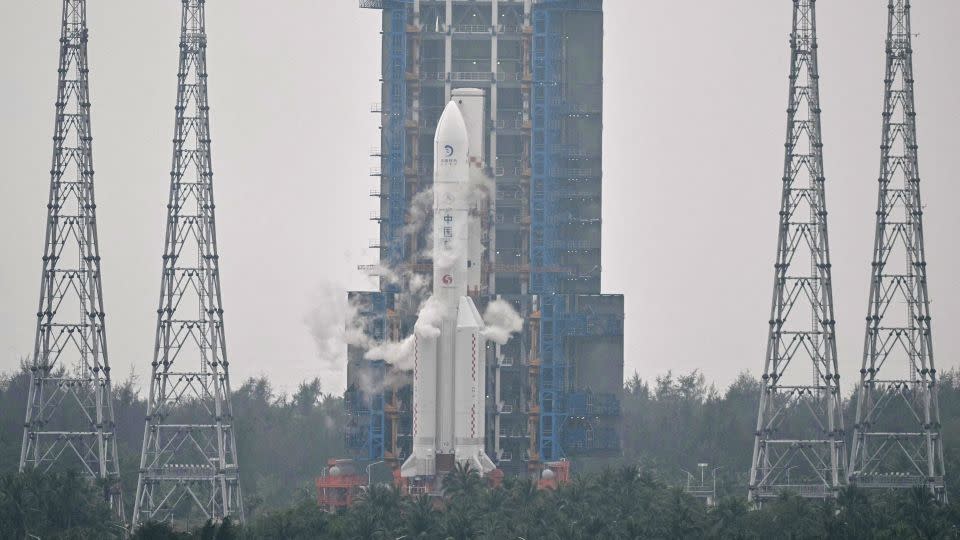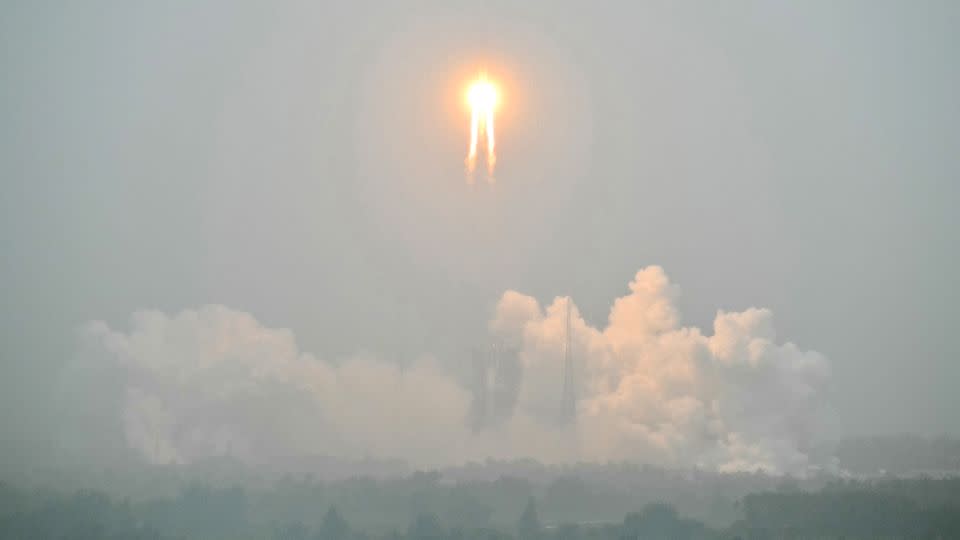China launches moon probe as space race with US heats up
Editor’s Note: Sign up for CNN’s Meanwhile in China newsletter which explores what you need to know about the country’s rise and how it impacts the world.
China launched an uncrewed lunar mission Friday that aims to bring back samples from the far side of the moon for the first time, in a potentially major step forward for the country’s ambitious space program.
The Chang’e-6 probe – China’s most complex robotic lunar mission to date – blasted off on a Long March-5 rocket from the Wenchang Space Launch Center in south China’s Hainan island, where space fans had gathered to watch the historic moment. The country’s National Space Administration said the launch was a success.
The launch marks the start of a mission that aims to be a key milestone in China’s push to become a dominant space power with plans to land astronauts on the moon by 2030 and build a research base on its south pole.
It comes as a growing number of countries, including the United States, eye the strategic and scientific benefits of expanded lunar exploration in an increasingly competitive field.
China’s planned 53-day mission would see the Chang’e-6 lander touch down in a gaping crater on the moon’s far side, which never faces Earth. China became the first and only country to land on the moon’s far side during its 2019 Chang’e-4 mission.
Any far-side samples retrieved by the Chang’e-6 lander could help scientists peer back into the evolution of the moon and the solar system itself – and provide important data to advance China’s lunar ambitions.
“The Chang’e-6 aims to achieve breakthroughs in the design and control technology of the moon’s retrograde orbit, intelligent sampling, take-off and ascent technologies, and automatic sample-return on the far side of the moon,” Ge Ping, deputy director of the China National Space Administration’s (CNSA) Center of Lunar Exploration and Space Engineering said last week from the launch site.
Ambitious mission
The Chang’e-6 probe will be a key test for China’s space capabilities in its effort to realize leader Xi Jinping’s “eternal dream” of building the country into a space power.
China has made rapid space advancements in recent years, in a field traditionally led by the United States and Russia.
With the Chang’e program, launched in 2007 and named for the moon goddess of Chinese mythology, China in 2013 became the first country to achieve a robotic lunar landing in nearly four decades. In 2022, China completed its own orbital space station, the Tiangong.

The technically complex Chang’e-6 mission builds on both the Chang’e-4’s 2019 record of landing on the far side of the moon, and Chang’e-5’s 2020 success returning to Earth with near-side moon samples.
This time, to communicate with Earth from the moon’s far side, Chang’e-6 must rely on the Queqiao-2 satellite, launched into lunar orbit in March.
The probe itself is composed of four parts: an orbiter, a lander, an ascender and a reentry module.
The mission plan is for the Chang’e-6’s lander to gather moon dust and rocks after touching down in the sprawling, roughly 2,500-kilometer diameter South Pole-Aitken basin, a crater formed some 4 billion years ago.
An ascender spacecraft would then transport the samples to the lunar orbiter for transfer to the reentry module and the mission’s return to Earth.
The complex mission “goes through virtually every step” that will be required for Chinese astronauts to land on the moon in the years ahead, according to James Head, a professor emeritus at Brown University who has collaborated with Chinese scientists leading the mission.
In addition to returning samples that could yield “fundamental new insights into the origin and early history of the moon and solar system,” the mission also serves as “robotic practice for these steps” to get astronauts to the moon and back, he said.

China plans to launch two more missions in the Chang-e series as it nears its 2030 target of sending astronauts to the moon before building a research station in the following decade on the lunar south pole – a region believed to contain water ice.
Chang’e-7, scheduled for 2026, will aim to search for resources on the moon’s south pole, while Chang’e-8 roughly two years later could look at how to utilize lunar materials to prepare for building the research base, Chinese officials have said.
Competitive space
Friday’s launch comes as multiple nations ramp up their lunar programs amid a growing focus on the potential access to resources and further deep space exploration access that successful moon missions could bring.
Last year, India landed its first spacecraft on the moon, while Russia’s first lunar mission in decades ended in failure when its Luna 25 probe crashed into the moon’s surface.
In January, Japan became the fifth country to land a spacecraft on the moon, though its Moon Sniper lander faced power issues due to an incorrect landing angle. The following month, IM-1, a NASA-funded mission designed by Texas-based private firm Intuitive Machines, touched down close to the south pole.
That landing – the first by a US-made spacecraft in over five decades – is among several planned commercial missions intended to explore the lunar surface before NASA attempts to return US astronauts there as soon as 2026 and build its scientific base camp.
NASA administrator Bill Nelson last month appeared to acknowledge that China’s pace – and concerns about its intentions – were driving the American urgency to return to the moon, decades after its Apollo-crewed missions.
“We believe that a lot of their so-called civilian space program is a military program. I think in effect we are in a race,” Nelson told lawmakers last month, adding his concern that China could try to bar the US or other countries from certain lunar areas if they arrive there first.
China has long said it stands for the peaceful use of space, and, like the US, has looked to use its space prowess to cultivate international goodwill.
This time, China has said the Chang’e-6 mission carries scientific instruments or payloads from France, Italy, Pakistan and the European Space Agency.
“China hopes to strengthen cooperation with its international counterparts and deepen international cooperation in the space field,” Ge of the CNSA told reporters a day ahead of the launch.
CNN’s Sawn Deng contributed reporting.
For more CNN news and newsletters create an account at CNN.com

